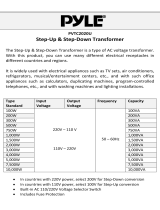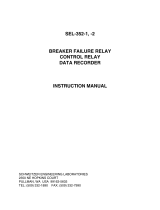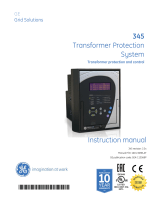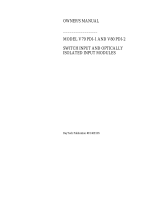ABB Relion 670 series User manual
- Category
- Measuring, testing & control
- Type
- User manual
This manual is also suitable for

Relion
®
670 series
Generator protection REG670 ANSI
Customized
Product Guide

Contents
1. Application.........................................................................3
2. Available functions...........................................................10
3. Differential protection.......................................................17
4. Impedance protection......................................................20
5. Current protection............................................................20
6. Voltage protection............................................................23
7. Frequency protection.......................................................25
8. Multipurpose protection...................................................26
9. Secondary system supervision.........................................27
10. Control...........................................................................27
11. Logic..............................................................................29
12. Monitoring......................................................................30
13. Metering.........................................................................32
14. Basic IED functions.........................................................32
15. Human machine interface...............................................32
16. Station communication ..................................................33
17. Remote communication..................................................34
18. Hardware description......................................................34
19. Connection diagrams......................................................38
20. Technical data................................................................47
21. Ordering.........................................................................95
Disclaimer
© Copyright 2012 ABB.
All rights reserved.
Trademarks
ABB and Relion are registered trademarks of ABB Group. All other brand or product names mentioned in this document may be trademarks or registered trademarks of
their respective holders.
Generator protection REG670 ANSI 1MRK 502 031-BUS B
Customized
Product version: 1.2
2 ABB

1. Application
The REG670 is used for protection, control and
monitoring of generators and generator-transformer
blocks from relatively small units up to the largest
generating units. The IED has a comprehensive
function library, covering the requirements for most
generator applications. The large number of analog
inputs available enables, together with the large
functional library, integration of many functions in
one IED. In typical applications two units can
provide total functionality, also providing a high
degree of redundancy. REG670 can as well be used
for protection and control of shunt reactors.
Stator ground fault protection, both traditional 95%
as well as 100% injection and 3rd harmonic based
are included. When the injection based protection is
used, 100% of the machine stator winding,
including the star point, is protected under all
operating modes. The 3rd harmonic based 100%
stator earth fault protection uses 3rd harmonic
differential voltage principle. Injection based 100%
stator ground fault protection can operate even
when machine is at standstill. Well proven
algorithms for pole slip, underexcitation, rotor
ground fault, negative sequence current
protections, and so on, are included in the IED.
The generator differential protection in the REG670
adapted to operate correctly for generator
applications where factors as long DC time
constants and requirement on short trip time have
been considered.
As many of the protection functions can be used as
multiple instances there are possibilities to protect
more than one object in one IED. It is possible to
have protection for an auxiliary power transformer
integrated in the same IED having main protections
for the generator. The concept thus enables very
cost effective solutions.
The REG670 also enables valuable monitoring
possibilities as many of the process values can be
transferred to an operator HMI.
The wide application flexibility makes this product
an excellent choice for both new installations and
for refurbishment in existing power plants.
Serial data communication is via optical
connections to ensure immunity against
disturbances.
The wide application flexibility makes this product
an excellent choice for both new installations and
the refurbishment of existing installations.
By using patented algorithm REG670 (or any other
product from 670 series) can track the power
system frequency in quite wide range from 9Hz to
95Hz. In order to do that preferably the three-phase
voltage signal from the generator terminals shall be
connected to the IED. Then IED can adopt its
filtering algorithm in order to properly measure
phasors of all current and voltage signals connected
to the IED. This feature is essential for proper
operation of the protection during generator start-
up and shut-down procedure.
Generator protection REG670 ANSI 1MRK 502 031-BUS B
Customized
Product version: 1.2 Issued: May 2012
Revision: B
ABB 3

IEC11000201-1-en.vsd
G
U
U
STEF PHIZ
59THD U3d/N
GEN PDIF
87G 3Id/I
SA PTUF
81 f<
SA PTOF
81 f>
SDD RFUF
60FL
OEX PVPH
24 U/f>
UV2 PTUV
27 3U<
OV2 PTOV
59 3U>
REG 670*1.2
ZMH PDIS
21 Z<
LEX PDIS
40 <
GUP PDUP
37 P<
GOP PDOP
32 P
ROV2 PTOV
59N 3Uo>
OC4 PTOC
51/67 3I->
CC RBRF
50BF 3I> BF
NS2 PTOC
46 I2>
TR PTTR
49 Ith
PSP PPAM
78 Ucos
+ REX060, REX061
AEG GAPC
50AE U/I>
CV MMXU
Meter.
ROV2 PTOV
59N UN>
ROTI PHIZ
64R R
RE
<
STTI PHIZ
64S R
SE
<
+ REX060
ROV2 PTOV
59N 3Uo>
VT
Y
Y
D
IEC11000201 V1 EN
Figure 1. Generator protection application with generator differential, 100% stator ground fault and back-up protection
Generator protection REG670 ANSI 1MRK 502 031-BUS B
Customized
Product version: 1.2
4 ABB

IEC11000204-1-en.vsd
G
U
U
GEN PDIF
87G 3Id/I
SA PTUF
81 f<
SA PTOF
81 f>
SDD RFUF
60FL
OEX PVPH
24 U/f>
UV2 PTUV
27 3U<
OV2 PTOV
59 3U>
REG 670*1.2
ZMH PDIS
21 Z<
LEX PDIS
40 <
GUP PDUP
37 P<
GOP PDOP
32 P
ROV2 PTOV
59N 3Uo>
OC4 PTOC
51/67 3I->
CC RBRF
50BF 3I> BF
NS2 PTOC
46 I2>
PSP PPAM
78 Ucos
+ REX060, REX061
AEG GAPC
50AE U/I>
CV MMXU
Meter.
ROTI PHIZ
64R R
RE
<
STTI PHIZ
64S R
SE
<
+ REX060
ROV2 PTOV
59N 3Uo>
VT
EF4 PTOC
64W IN>
Y
Y
S
D
IEC11000204 V1 EN
Figure 2. Generator protection application for generator with split winding including generator phase differential,
100% stator ground fault and back-up protection
Generator protection REG670 ANSI 1MRK 502 031-BUS B
Customized
Product version: 1.2
ABB 5

IEC11000206-1-en.vsd
G
U
U
STEF PHIZ
59THD U3d/N
GEN PDIF
87G 3Id/I
SA PTUF
81 f<
SA PTOF
81 f>
SDD RFUF
60FL
OEX PVPH
24 U/f>
UV2 PTUV
27 3U<
OV2 PTOV
59 3U>
REG 670*1.2
ZMH PDIS
21 Z<
LEX PDIS
40 <
GUP PDUP
37 P<
GOP PDOP
32 P
ROV2 PTOV
59N 3Uo>
OC4 PTOC
51/67 3I->
CC RBRF
50BF 3I> BF
NS2 PTOC
46 I2>
PSP PPAM
78 Ucos
+ REX060, REX061
AEG GAPC
50AE U/I>
CV MMXU
Meter.
ROV2 PTOV
59N UN>
ROTI PHIZ
64R R
RE
<
VT
EF4 PTOC
64W IN>
Y
Y
STTI PHIZ
64S R
SE
<
+ REX060
VT
GEN PDIF
87W 3Id/I
D
S
IEC11000206 V1 EN
Figure 3. Generator protection application for generator with split winding including generator phase differential,
generator split-phase differential, 100% stator ground fault and back-up protection
Generator protection REG670 ANSI 1MRK 502 031-BUS B
Customized
Product version: 1.2
6 ABB

IEC11000202-1-en.vsd
G
U
U
ROV2 PTOV
59N UN>
GEN PDIF
87G 3Id/I
SA PTUF
81 f<
SA PTOF
81 f>
SDD RFUF
60FL
REG 670*1.2
ZMH PDIS
21 Z<
LEX PDIS
40 <
GUP PDUP
37 P<
GOP PDOP
32 P
OC4 PTOC
51/67 3I->
CC RBRF
50BF 3I> BF
NS2 PTOC
46 I2>
TR PTTR
49 Ith
PSP PPAM
78 Ucos
AEG GAPC
50AE U/I>
STEF PHIZ
59THD U3d/N
Auxiliary Bus
OC4 PTOC
50/51 3I>
OC4 PTOC
50/51 3I>
CC RBRF
50BF 3I> BF
OC4 PTOC
50/51 3I>
ROV2 PTOV
59N 3Uo>
T3W PDIF
87T 3Id/I
CV MMXU
Meter.
OEX PVPH
24 U/f>
UV2 PTUV
27 3U<
OV2 PTOV
59 3U>
ROV2 PTOV
59N 3Uo>
+ REX060, REX061
STTI PHIZ
64S R
SE
<
ROTI PHIZ
64R R
RE
<
+ REX060, REX062
Y
Y
Y
Unit Trafo
A
u
x
i
l
i
a
r
y
T
r
a
f
o
E
x
c
i
t
a
t
i
o
n
T
r
a
f
o
Y
Y
Grounding
Transformer
D
D
D
IEC11000202 V1 EN
Figure 4. Unit protection application with overall differential, generator differential, 100% stator ground fault and back-
up protection. Stator winding grounded via grounding transformer.
Generator protection REG670 ANSI 1MRK 502 031-BUS B
Customized
Product version: 1.2
ABB 7

IEC11000203-1-en.vsd
G
U
U
STEF PHIZ
59THD U3d/N
TR PTTR
49 Ith
SA PTUF
81 f<
EF4 PTOC
50N/51N
IN>
REF PDIF
87N IdN/I
T3W PDIF
87O 3Id/I
REG 670*1.2
T2W PDIF
87T 3Id/I
ROV2 PTOV
59N 3Uo>
NS2 PTOC
46 I2>
TR PTTR
49 Ith
SDD RFUF
60FL
ZMH PDIS
21 Z<
LEX PDIS
40 <
GUP PDUP
37 P<
GOP PDOP
32 P
PSP PPAM
78 Ucos
SA PTOF
81 f>
OEX PVPH
24 U/f>
UV2 PTUV
27 3U<
OV2 PTOV
59 3U>
OC4 PTOC
50/51 3I>
OC4 PTOC
50/51 3I>
CC RBRF
50BF 3I> BF
GEN PDIF
87G 3Id/I
ROV2 PTOV
59N UN>
CC RBRF
50BF 3I> BF
OC4 PTOC
51/67 3I->
AEG GAPC
50AE U/I>
CV MMXU
Meter.
+ REX060, REX061
STTI PHIZ
64S R
SE
<
ROTI PHIZ
64R R
RE
<
+ REX060
CV MMXU
Meter.
Y
Y
Y
Y
Y
U
n
i
t
T
r
a
f
o
VT
D
D
D
IEC11000203 V1 EN
Figure 5. Unit protection application with overall differential, unit transformer differential, generator differential, 100%
stator ground fault and back-up protection. Ungrounded stator winding.
Generator protection REG670 ANSI
1MRK 502 031-BUS B
Customized
Product version: 1.2
8 ABB

G
U
U
TR PTTR
49 Ith
SA PTUF
81 f<
EF4 PTOC
50N/51N
IN>
REF PDIF
87N IdN/I
T3W PDIF
87O 3Id/I
REG 670*1.2
T2W PDIF
87T 3Id/I
ROV2 PTOV
59N 3Uo>
NS2 PTOC
46 I2>
TR PTTR
49 Ith
SDD RFUF
60FL
ZMH PDIS
21 Z<
LEX PDIS
40 <
GUP PDUP
37 P<
GOP PDOP
32 P
PSP PPAM
78 Ucos
SA PTOF
81 f>
OEX PVPH
24 U/f>
UV2 PTUV
27 3U<
OV2 PTOV
59 3U>
OC4 PTOC
50/51 3I>
OC4 PTOC
50/51 3I>
CC RBRF
50BF 3I> BF
GEN PDIF
87G 3Id/I
CC RBRF
50BF 3I> BF
OC4 PTOC
51/67 3I->
AEG GAPC
50AE U/I>
CV MMXU
Meter.
+ REX060, REX061
STTI PHIZ
64S R
SE
<
ROTI PHIZ
64R R
RE
<
+ REX060
CV MMXU
Meter.
Y
Y
Y
Y
Y
U
n
i
t
T
r
a
f
o
ROV2 PTOV
59N 3Uo>
VT
IEC11000207-1-en.vsd
D
D
D
IEC11000207 V1 EN
Figure 6. Unit protection application with overall differential, unit transformer differential, generator differential, 100%
stator ground fault and back-up protection. Stator winding grounded via primary resistor.
Generator protection REG670 ANSI 1MRK 502 031-BUS B
Customized
Product version: 1.2
ABB 9

2. Available functions
Main protection functions
2 = number of basic instances
0-3 = option quantities
IEC 61850 ANSI Function description Generator
REG670
Differential protection
T2WPDIF 87T Transformer differential protection, two winding 0-2
T3WPDIF 87T Transformer differential protection, three winding 0-2
HZPDIF 87 1Ph high impedance differential protection 0-6
GENDIF 87G Generator differential protection 0-2
REFPDIF 87N Restricted earth fault protection, low impedance 0-3
Impedance protection
ZMHPDIS 21 Full-scheme distance protection, mho characteristic 0-4
ZDMRDIR 21D Directional impedance element for mho characteristic 0-2
PSPPPAM 78 Pole slip/out-of-step protection 0-1
LEXPDIS 40 Loss of excitation 0-2
Generator protection REG670 ANSI 1MRK 502 031-BUS B
Customized
Product version: 1.2
10 ABB

Back-up protection functions
IEC 61850 ANSI Function description Generator
REG670
Current protection
PHPIOC 50 Instantaneous phase overcurrent protection 0-4
OC4PTOC 51_67 Four step phase overcurrent protection 0-6
EFPIOC 50N Instantaneous residual overcurrent protection 0-2
EF4PTOC 51N_67
N
Four step residual overcurrent protection 0-6
NS4PTOC 46I2 Four step directional negative phase sequence overcurrent protection 0-2
SDEPSDE 67N Sensitive directional residual overcurrent and power protection 0-2
TRPTTR 49 Thermal overload protection, two time constant 0-3
CCRBRF 50BF Breaker failure protection 0-4
CCRPLD 52PD Pole discordance protection 0-4
GUPPDUP 37 Directional underpower protection 0-4
GOPPDOP 32 Directional overpower protection 0-4
NS2PTOC 46I2 Negative sequence time overcurrent protection for machines 0-2
AEGGAPC 50AE Accidental energizing protection for synchronous generator 0-2
Voltage protection
UV2PTUV 27 Two step undervoltage protection 0-2
OV2PTOV 59 Two step overvoltage protection 0-2
ROV2PTOV 59N Two step residual overvoltage protection 0-3
OEXPVPH 24 Overexcitation protection 0-2
VDCPTOV 60 Voltage differential protection 0-2
STEFPHIZ 59THD 100% stator earth fault protection, 3rd harmonic based 0-1
Frequency protection
SAPTUF 81 Underfrequency protection 0-6
SAPTOF 81 Overfrequency protection 0-6
SAPFRC 81 Rate-of-change frequency protection 0-3
Generator protection REG670 ANSI 1MRK 502 031-BUS B
Customized
Product version: 1.2
ABB 11

IEC 61850 ANSI Function description Generator
REG670
Multipurpose protection
CVGAPC General current and voltage protection 1-12
64R Rotor earth fault 1
Generator protection REG670 ANSI 1MRK 502 031-BUS B
Customized
Product version: 1.2
12 ABB

Control and monitoring functions
IEC 61850 ANSI Function description Generator
REG670
Control
SESRSYN 25 Synchrocheck, energizing check and synchronizing 0-2
APC30 3 Apparatus control for up to 6 bays, max 30 apparatuses (6CBs) incl.
interlocking
0-1
QCBAY Apparatus control 1
Local
Remote
Handling of LRswitch positions 1
LocRem
Control
LHMI control of PSTO 1
TCMYLTC 84 Tap changer control and supervision, 6 binary inputs 0-4
TCLYLTC 84 Tap changer control and supervision, 32 binary inputs 0-4
SLGGIO Logic rotating switch for function selection and LHMI presentation 15
VSGGIO Selector mini switch 20
DPGGIO IEC61850 generic communication I/O functions 16
SPC8GGIO Single pole generic control 8 signals 5
AutomationBits AutomationBits, command function for DNP3.0 3
Single command, 16 signals 4
Secondary system supervision
CCSRDIF 87 Current circuit supervision 0-5
SDDRFUF Fuse failure supervision 0-3
Logic
SMPPTRC 94 Tripping logic 1-6
TMAGGIO Trip matrix logic 12
Configuration logic blocks 40-280
Fixed signal function blocks 1
B16I Boolean 16 to Integer conversion 16
B16IFCVI Boolean 16 to Integer conversion with Logic Node representation 16
IB16 Integer to Boolean 16 conversion 16
IB16FVCB Integer to Boolean 16 conversion with Logic Node representation 16
Generator protection REG670 ANSI 1MRK 502 031-BUS B
Customized
Product version: 1.2
ABB 13

IEC 61850 ANSI Function description Generator
REG670
Monitoring
CVMMXN Measurements 6
CNTGGIO Event counter 5
Event Event function 20
DRPRDRE Disturbance report 1
SPGGIO IEC61850 generic communication I/O functions 64
SP16GGIO IEC61850 generic communication I/O functions 16 inputs 16
MVGGIO IEC61850 generic communication I/O functions 24
BSStart
Report
Logical signal status report 3
RANGE_XP Measured value expander block 66
Metering
PCGGIO Pulse-counter logic 16
ETPMMTR Function for energy calculation and demand handling 6
Generator protection REG670 ANSI 1MRK 502 031-BUS B
Customized
Product version: 1.2
14 ABB

Designed to communicate
IEC 61850 ANSI Function description Generator
REG670
Station communication
DNP3.0 for TCP/IP and EIA-485
communication protocol
1
DNP3.0 fault records for TCP/IP and
EIA-485 communication protocol
1
Parameter setting function for
IEC61850
1
IntlReceive Horizontal communication via
GOOSE for interlocking
59
Goose binary receive 10
Multiple command and transmit 60/10
Ethernet configuration of links 1
IEC 62439-3 Edition 1 parallel
redundancy protocol
0-1
IEC 62439-3 Edition 2 parallel
redundancy protocol
0-1
Generator protection REG670 ANSI 1MRK 502 031-BUS B
Customized
Product version: 1.2
ABB 15

Basic IED functions
IEC 61850 Function description
Basic functions included in all products
IntErrorSig Self supervision with internal event list 1
TIME Time and synchronization error 1
TimeSynch Time synchronization 1
ActiveGroup Parameter setting groups 1
Test Test mode functionality 1
ChangeLock Change lock function 1
TerminalID IED identifiers 1
Productinfo Product information 1
MiscBaseCommon Misc Base Common 1
IEDRuntimeComp IED Runtime Comp 1
RatedFreq Rated system frequency 1
SMBI Signal Matrix for binary inputs 40
SMBO Signal Matrix for binary outputs 40
SMMI Signal Matrix for mA inputs 4
SMAI Signal Matrix for analog inputs 36
Sum3Ph Summation block 3 phase 18
LocalHMI Parameter setting function for HMI in PCM600 1
LocalHMI Local HMI signals 1
AuthStatus Authority status 1
AuthorityCheck Authority check 1
AccessFTP FTP access with password 1
SPACommMap SPA communication mapping 1
DOSFRNT Denial of service, frame rate control for front port 1
DOSOEMAB Denial of service, frame rate control for OEM port AB 1
DOSOEMCD Denial of service, frame rate control for OEM port CD 1
Generator protection REG670 ANSI 1MRK 502 031-BUS B
Customized
Product version: 1.2
16 ABB

3. Differential protection
Generator differential protection GENPDIF (87G)
Short circuit between the phases of the stator
windings causes normally very large fault currents.
The short circuit gives risk of damages on
insulation, windings and stator iron core. The large
short circuit currents cause large forces, which can
cause damage even to other components in the
power plant, such as turbine and generator-turbine
shaft.
To limit the damage due to stator winding short
circuits, the fault clearance must be as fast as
possible (instantaneous). If the generator block is
connected to the power system close to other
generating blocks, the fast fault clearance is
essential to maintain the transient stability of the
non-faulted generators.
Normally, the short circuit fault current is very large,
that is, significantly larger than the generator rated
current. There is a risk that a short circuit can occur
between phases close to the neutral point of the
generator, thus causing a relatively small fault
current. The fault current can also be limited due to
low excitation of the generator. Therefore, it is
desired that the detection of generator phase-to-
phase short circuits shall be relatively sensitive,
detecting small fault currents.
It is also of great importance that the generator
differential protection does not trip for external
faults, with large fault currents flowing from the
generator.
To combine fast fault clearance, as well as
sensitivity and selectivity, the generator differential
protection is normally the best choice for phase-to-
phase generator short circuits.
Generator differential protection GENPDIF (87G) is
also well suited to generate fast, sensitive and
selective fault clearance, if used to protect shunt
reactors or small busduct.
Transformer differential protection T2WPDIF/
T3WPDIF (87T)
The Transformer differential protection, two-winding
(T2WPDIF, 87T) and Transformer differential
protection, three-winding (T3WPDIF, 87T) are
provided with internal CT ratio matching and phase
shift compensation and settable zero sequence
current elimination.
The function can be provided with up to three-
phase sets of current inputs. All current inputs are
provided with percentage bias restraint features,
making the IED suitable for two- or three-winding
transformer in multi-breaker station arrangements.
Generator protection REG670 ANSI 1MRK 502 031-BUS B
Customized
Product version: 1.2
ABB 17

Two-winding applications
xx05000048_ansi.vsd
152
352
ANSI05000048 V1 EN
two-winding power transformer
xx05000049_ansi.vsd
152
352
ANSI05000049 V1 EN
two-winding power transformer with
unconnected delta tertiary winding
xx05000050_ansi.vsd
352
252
152
ANSI05000050 V1 EN
two–winding power transformer with two circuit
breakers on one side
xx05000051_ansi.vsd
252
152
352
452
ANSI05000051 V1 EN
two–winding power transformer with two circuit
breakers and two CT-sets on both sides
Three-winding applications
xx05000052_ansi.vsd
352
152
452
ANSI05000052 V1 EN
three–winding power transformer with all three
windings connected
Generator protection REG670 ANSI 1MRK 502 031-BUS B
Customized
Product version: 1.2
18 ABB

xx05000053_ansi.vsd
352
452
252
152
ANSI05000053 V1 EN
three–winding power transformer with two circuit
breakers and two CT-sets on one side
xx05000057_ansi.vsd
552
152 252
352 452
ANSI05000057 V1 EN
Autotransformer with two circuit breakers and
two CT-sets on two out of three sides
Figure 7. CT group arrangement for
differential protection and other
protections
The setting facilities cover the applications of the
differential protection to all types of power
transformers and auto-transformers with or without
load tap changer as well as for shunt reactors or
and local feeders within the station. An adaptive
stabilizing feature is included for heavy through-
faults.By introducing the load tap changer position,
the differential protection pick-up can be set to
optimum sensitivity thus covering internal faults with
low fault level.
Harmonic restraint is included for inrush currents as
well as for overexcitation conditions. Adaptive
stabilization is also included for system recovery
inrush and CT saturation for external faults. A high
set unrestrained differential current protection is
included for a very high speed tripping at a high
internal fault currents.
An innovative sensitive differential protection
feature, based on the theory of symmetrical
components, offers the best possible coverage for
power transformer winding turn-to-turn faults.
1Ph High impedance differential protection HZPDIF
(87)
The 1Ph High impedance differential protection
(HZPDIF, 87) function can be used when the
involved CTs have the same turns ratio and similar
magnetizing characteristics. It utilizes an external
CT current summation by wiring, a series resistor,
and a voltage dependent resistor which are
mounted externally connected to the IED.
HZPDIF (87) can be used to protect generator
stator windings, tee-feeders or busbars. Six single
phase function blocks are available to allow
application for two three-phase zones busbar
protection.
Restricted earth fault protection, low impedance
REFPDIF (87N)
Restricted earth-fault protection, low-impedance
function (REFPDIF, 87N) can be used on all solidly
or low-impedance grounded windings. The
REFPDIF (87N) function provides high sensitivity
(down to 5%) and high speed tripping as it
measures each winding individually and thus does
not need inrush stabilization.
The low-impedance function is a percentage biased
function with an additional zero sequence current
directional comparison criterion. This gives excellent
sensitivity and stability during through faults. The
function allows the use of different CT ratios and
magnetizing characteristics on the phase and
neutral CT cores and mixing with other functions
and protection IEDs on the same cores.
Generator protection REG670 ANSI
1MRK 502 031-BUS B
Customized
Product version: 1.2
ABB 19

4. Impedance protection
Full-scheme distance measuring, Mho
characteristic ZMHPDIS (21)
The numerical mho line distance protection is a four
zone full scheme protection for back-up detection
of short circuit and ground faults. The four zones
have fully independent measuring and settings,
which gives high flexibility for all types of lines.
The function can be used as under impedance back-
up protection for transformers and generators.
Directional impedance element for Mho
characteristic ZDMRDIR
The phase-to-ground impedance elements can be
optionally supervised by a phase unselective
directional function (phase unselective, because it is
based on symmetrical components).
Pole slip protection PSPPPAM (78)
The situation with pole slip of a generator can be
caused by different reasons.
A short circuit may occur in the external power grid,
close to the generator. If the fault clearing time is
too long, the generator will accelerate so much, that
the synchronism cannot be maintained.
Un-damped oscillations occur in the power system,
where generator groups at different locations,
oscillate against each other. If the connection
between the generators is too weak the magnitude
of the oscillations will increase until the angular
stability is lost.
The operation of a generator having pole slip will
give risk of damages to the generator, shaft and
turbine.
• At each pole slip there will be significant torque
impact on the generator-turbine shaft.
• In asynchronous operation there will be
induction of currents in parts of the generator
normally not carrying current, thus resulting in
increased heating. The consequence can be
damages on insulation and stator/rotor iron.
The Pole slip protection (PSPPPAM ,78) function
shall detect pole slip conditions and trip the
generator as fast as possible if the locus of the
measured impedance is inside the generator-
transformer block. If the centre of pole slip is
outside in the power grid, the first action should be
to split the network into two parts, after line
protection action. If this fails there should be
operation of the generator PSPPPAM (78) in zone 2,
to prevent further damages to the generator, shaft
and turbine.
Loss of excitation LEXPDIS (40)
There are limits for the under-excited operation of a
synchronous machine. A reduction of the excitation
current weakens the coupling between the rotor
and the stator. The machine may lose the
synchronism and start to operate like an induction
machine. Then, the reactive power consumption will
increase. Even if the machine does not loose
synchronism it may not be acceptable to operate in
this state for a long time. Reduction of excitation
increases the generation of heat in the end region of
the synchronous machine. The local heating may
damage the insulation of the stator winding and the
iron core.
To prevent damages to the generator it should be
tripped when excitation is lost.
5. Current protection
Instantaneous phase overcurrent protection
PHPIOC (50)
The instantaneous three phase overcurrent function
has a low transient overreach and short tripping
time to allow use as a high set short-circuit
protection function.
Four step phase overcurrent protection OC4PTOC
(51/67)
The four step phase overcurrent protection function
OC4PTOC (51/67) has independent inverse time
delay settings for step 1 and 4. Step 2 and 3 are
always definite time delayed.
All IEC and ANSI inverse time characteristics are
available together with an optional user defined time
characteristic.
Generator protection REG670 ANSI
1MRK 502 031-BUS B
Customized
Product version: 1.2
20 ABB
Page is loading ...
Page is loading ...
Page is loading ...
Page is loading ...
Page is loading ...
Page is loading ...
Page is loading ...
Page is loading ...
Page is loading ...
Page is loading ...
Page is loading ...
Page is loading ...
Page is loading ...
Page is loading ...
Page is loading ...
Page is loading ...
Page is loading ...
Page is loading ...
Page is loading ...
Page is loading ...
Page is loading ...
Page is loading ...
Page is loading ...
Page is loading ...
Page is loading ...
Page is loading ...
Page is loading ...
Page is loading ...
Page is loading ...
Page is loading ...
Page is loading ...
Page is loading ...
Page is loading ...
Page is loading ...
Page is loading ...
Page is loading ...
Page is loading ...
Page is loading ...
Page is loading ...
Page is loading ...
Page is loading ...
Page is loading ...
Page is loading ...
Page is loading ...
Page is loading ...
Page is loading ...
Page is loading ...
Page is loading ...
Page is loading ...
Page is loading ...
Page is loading ...
Page is loading ...
Page is loading ...
Page is loading ...
Page is loading ...
Page is loading ...
Page is loading ...
Page is loading ...
Page is loading ...
Page is loading ...
Page is loading ...
Page is loading ...
Page is loading ...
Page is loading ...
Page is loading ...
Page is loading ...
Page is loading ...
Page is loading ...
Page is loading ...
Page is loading ...
Page is loading ...
Page is loading ...
Page is loading ...
Page is loading ...
Page is loading ...
Page is loading ...
Page is loading ...
Page is loading ...
Page is loading ...
Page is loading ...
Page is loading ...
Page is loading ...
Page is loading ...
Page is loading ...
Page is loading ...
Page is loading ...
Page is loading ...
Page is loading ...
Page is loading ...
Page is loading ...
Page is loading ...
Page is loading ...
Page is loading ...
Page is loading ...
Page is loading ...
-
 1
1
-
 2
2
-
 3
3
-
 4
4
-
 5
5
-
 6
6
-
 7
7
-
 8
8
-
 9
9
-
 10
10
-
 11
11
-
 12
12
-
 13
13
-
 14
14
-
 15
15
-
 16
16
-
 17
17
-
 18
18
-
 19
19
-
 20
20
-
 21
21
-
 22
22
-
 23
23
-
 24
24
-
 25
25
-
 26
26
-
 27
27
-
 28
28
-
 29
29
-
 30
30
-
 31
31
-
 32
32
-
 33
33
-
 34
34
-
 35
35
-
 36
36
-
 37
37
-
 38
38
-
 39
39
-
 40
40
-
 41
41
-
 42
42
-
 43
43
-
 44
44
-
 45
45
-
 46
46
-
 47
47
-
 48
48
-
 49
49
-
 50
50
-
 51
51
-
 52
52
-
 53
53
-
 54
54
-
 55
55
-
 56
56
-
 57
57
-
 58
58
-
 59
59
-
 60
60
-
 61
61
-
 62
62
-
 63
63
-
 64
64
-
 65
65
-
 66
66
-
 67
67
-
 68
68
-
 69
69
-
 70
70
-
 71
71
-
 72
72
-
 73
73
-
 74
74
-
 75
75
-
 76
76
-
 77
77
-
 78
78
-
 79
79
-
 80
80
-
 81
81
-
 82
82
-
 83
83
-
 84
84
-
 85
85
-
 86
86
-
 87
87
-
 88
88
-
 89
89
-
 90
90
-
 91
91
-
 92
92
-
 93
93
-
 94
94
-
 95
95
-
 96
96
-
 97
97
-
 98
98
-
 99
99
-
 100
100
-
 101
101
-
 102
102
-
 103
103
-
 104
104
-
 105
105
-
 106
106
-
 107
107
-
 108
108
-
 109
109
-
 110
110
-
 111
111
-
 112
112
-
 113
113
-
 114
114
-
 115
115
ABB Relion 670 series User manual
- Category
- Measuring, testing & control
- Type
- User manual
- This manual is also suitable for
Ask a question and I''ll find the answer in the document
Finding information in a document is now easier with AI
Related papers
-
ABB Relion 650 series ANSI Engineering Manual
-
ABB RELION 650 SERIES Operating instructions
-
ABB Relion REG670 User manual
-
ABB DNP3 Point List Manual
-
ABB Relion REG670 Installation And Commissioning Manual
-
ABB RER620 Technical Manual
-
ABB REC650 ANSI Technical Manual
-
ABB REG650 ANSI Technical Manual
-
ABB REC650 ANSI Technical Manual
-
ABB REJ603 User manual
Other documents
-
 PyleMeters PVTC2020U Owner's manual
PyleMeters PVTC2020U Owner's manual
-
 SIFANG CSC-161 User manual
SIFANG CSC-161 User manual
-
Megger TTR25 User manual
-
wanwu communication DTS866 User manual
-
Mitsubishi Electric MELPRO-D Series TRANSFORMER PROTECTION RELAY CAC1-A41D1 Owner's manual
-
Siemens Argus 7SR22 Technical Manual
-
 Schweitzer Engineering Laboratories SEL-352-2 User manual
Schweitzer Engineering Laboratories SEL-352-2 User manual
-
Siemens Argus 7SR12 User manual
-
 GE Multilin 345 User manual
GE Multilin 345 User manual
-
 Bay Technical Associates V79 PDI-1 User manual
Bay Technical Associates V79 PDI-1 User manual























































































































